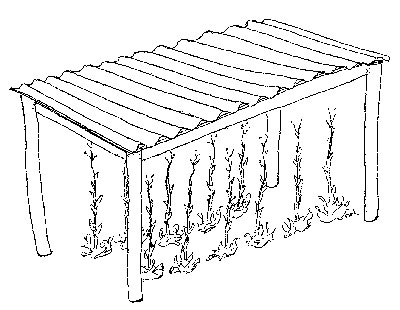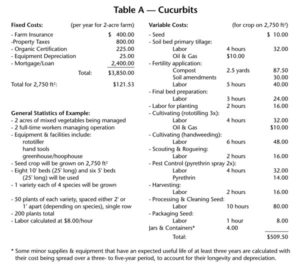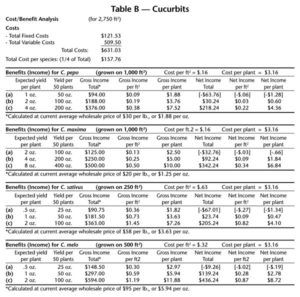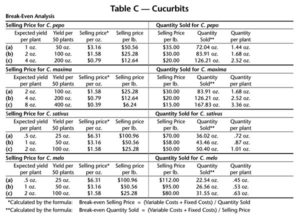By Nicolas Lindholm
This is the second of five articles covering some of the most commonly produced and potentially profitable seed crops being grown by small-scale organic and biodynamic farmers in the Northeast. Supported primarily through a grant from the Maine Dept. of Agriculture, I studied almost 30 farms in New England and New York, including large retail and small farm-based seed companies, market gardeners and family farms, CSAs, nonprofit groups, and a USDA farm that is part of our National Plant Germplasm System. Other articles in the series cover lettuce, tomatoes (Dec. 2000-Feb. 2001 MOF&G), beans/peas, and brassicas.
This study and these articles are meant to promote dialogue and develop interest in a niche market opportunity that a growing group of farmers and industry supporters has been developing over the past 10 to 20 years: seed crop production on small farms in the Northeast. By this, I mean growing and marketing seeds of vegetable, herb and flower varieties for other farmers and gardeners to purchase, plant and grow. These seeds are directly marketed to the consumer or sold wholesale to regional seed companies. Current popular interests and trends, including preserving genetic diversity, growing and saving heirloom varieties and open-pollinated varieties, organic gardening, and even anti-GMO concerns, have contributed to the rise of this largely untapped, potentially profitable niche market for small-scale, diversified organic farmers.
Most of the research and development efforts in organic seed crop growing and marketing to date have been done by seed companies in the Northeast and by a few farmers, mostly isolated from one another, each independently testing and overcoming production and marketing techniques and challenges. I believe that this is the first economic viability study of seed growing for small farmers in the Northeast, and the first attempt to consolidate the independent findings from experienced growers and producers. The results are encouraging for entrepreneurial farmers who want to explore new markets and grow new kinds of crops, remain diversified, and make sound marketing decisions based on economic analyses.
A New Way to Carve Your Pumpkin
Here in the Northeast, many experienced seed growers think highly and talk fondly of crops in the cucurbit family (winter and summer squashes, melons and cucumbers). These are very popular seed crops. All of the growers that I visited in my research, and most farmers who have tried any type of seed growing, have usually tried something in this family.
One reason for this popularity is that cucurbits generally grow well in our climate. They like the warmth and moderate rainfall of midsummer, and they don’t require a lot of pampering to mature ample fruit and produce good quantities of seed. Although many cucurbit species and varieties need longer, warmer seasons than ours, plenty of squash, melon and cuke varieties do produce abundantly in the Northeast, and many are part of our cultural cuisine, items we consider staples in our gardens and our diets (e.g., pie pumpkins, pickling cucumbers, zucchini and butternut squash).
Also, cucurbit fruits are relatively easy to harvest, handle and store, and seed extracting and processing is easy but time-consuming. Squashes, melons and cukes are “wet-seeded” crops (seeds are inside a fleshy fruit), so like tomatoes are not susceptible to diseases brought on by the heavy rains that we often receive in the Northeast at harvest time, as are such “dry-seeded” crops as beans and peas. Indeed, some growers leave the fruit on the vine through the first light frosts, which kills the plants and reveals the mature fruit, with no damage to the seeds.
In fact, cucurbit seed actually benefits from being left in the fruit for at least two weeks after harvest for “curing,” when starches change to sugars, excess moisture evaporates, and the fruit hardens into a state of dormancy, putting its energy into its seed. At this point, cucurbit fruits are more like a dry-seeded crop, as the shells are dry and very hard, with the seeds inside surrounded only by semi-moist pulp and stringy flesh. Most growers extract seed in a dry process, simply cutting or cracking open the shells and scooping out the seed. From there, many either rinse the seed from the pulp or soak it for a short time until the seed sinks and the pulp floats. Cucumbers, in particular, benefit from a simple fermentation process, identical to that used in tomato seed processing.
The volume of seed produced per fruit is another reason to grow cucurbits. For most varieties, it can be impressive. Anyone who’s eaten a seeded watermelon or scooped out the inside of a jack-o-lantern can attest to that. Several hundred to several thousand large seeds typically are found in a single cucurbit fruit.
Several challenges, however, exist in cucurbit seed crop production in the Northeast. The greatest, especially when integrating the seed crops into an operation that includes vegetable row crops, is to manage the proper pollination of each species without crossing with related species.
All cucurbits are monoecious and cross-pollinating. Each plant has separate male and female flowers, which require a pollinator — in this case, insects such as bees — to carry pollen from the male to the female flowers. Problems arise for seed growers because two varieties of the same species will cross with each other, intermix, and alter the unique genetic material that defines distinct varieties. Insect pollinators collecting pollen from an acorn squash (Cucurbita pepo), for example, can travel to nearby zucchini (also C. pepo) and pollinate female flowers of both with pollen from either. Therefore, to maintain genetic purity of any squash, cucumber or melon variety, a seed grower needs to know what species the plant is and keep it properly isolated from all other varieties of that species.
Most growers I’ve visited employ one of two techniques, sometimes both. The first and easiest (and therefore most efficient and economically viable) is isolation by distance. Different technical sources list differing isolation distances, but in general, most growers agree that at least a half mile is needed to isolate one variety of a given species from another to prevent crossing. Some feel that if large barriers, such as hedges, trees, woods and/or buildings, separate fields, then that isolation distance may be reduced. Basically, you want to ensure that a bee making its rounds in one field where one species of cucurbit is growing will return to its hive and clean itself of pollen before flying to and collecting pollen in another field where another variety of the same species is growing. Others believe that a half mile may not prevent crossing. Carol Deppe, in her book Breed Your Own Vegetable Varieties, recommends 1,000 to 1,500 meters and reminds you to check with your neighbors and be aware of what’s growing in their gardens (if they’re within that range).
So, although potentially problematic on some small farms, most seed growers separate cucurbit plots with distances ranging from 1/4 mile through woods to several miles apart. Fields owned by family or friends or neighbors are often rented or used for such small, isolated plots, thereby allowing a grower to raise a number of varieties of the same species in the same year.
The second most common technique for seed growers with cucurbits is isolation in time: One variety of a given species flowers and develops fruit before another variety of the same species in the same field. In the Northeast, this is accomplished by starting one variety early in a greenhouse, setting it out early, and ensuring that it has flowered and been pollinated before a later planting of a different variety (either transplanted or direct seeded) flowers. This method works well but takes more forethought, observation and field marking of pure fruit compared to isolation by distance.
Two other techniques, not considered by most to be economically viable but often described in seed saving books, are isolation through caging (using mesh cages to keep natural pollinators out, while introducing a small, pure population of pollinators for a short time during flowering) and hand-pollinating (using scissors and paint brushes to pollinate a crop before insects do). In general, the costs of material and/or labor required for these techniques make them unfavorable for commercial seed crop production.
 |
A unique trait of squashes, melons and cukes, especially in contrast with other cross-pollinating plants, is that they tend to act like self-pollinating crops regarding inbreeding. That is, although the cucurbits are outbreeders, requiring cross-pollination, they do not show a high degree of inbreeding depression, as most outbreeders do, so the plant population required to maintain a healthy gene pool of a given cucurbit variety is smaller than the population typically needed by outbreeding crops. This is beneficial, considering how much space vining cucurbits require. A population of several hundred plants per variety (as for corn seed crops) would make cucurbits economically unviable for most small-scale growers. With cucurbits, however, populations of 40 plants are suitable; some sources say 100 is ideal; most agree that 20 is a bare minimum.
Getting Seeds into the Soil
How can a grower incorporate cucurbit seed crops into his farm? As in my previous article, I have created an example (Table A), that is neither a composite of the farms and growers I visited nor a case study of one particular grower, but a generic and readily manipulated model to study and adapt. A reader can look at this “budget” and say, “Well, I can buy compost cheaper than that,” or, “I think I would need to spend twice that amount of time hand weeding,” or whatever variations might be evident on your own farm.
This hypothetical farm has 2 acres in vegetable production, managed by two full-time employees with some basic equipment, including a rototiller, hand tools, and a greenhouse/hoophouse for seedling production. For the example, they take a little more than 1/16 acre, or 2,750 ft2, and break it into 10′-wide and 5′-wide planting beds to grow 50 plants each of four separate species of cucurbits (two squashes, a melon and a cuke). This plot is located in one part of a field, which is isolated by at least 1/2 mile from any other fields where cucurbits are being grown.
As an aside, most seed growers do not recommend picking and marketing fruit from cucurbit seed crops. Not only would selling the fruit diminish the yield of seed per plant, but as cucurbit plants keep putting energy into producing new fruit, that energy is diverted from maturing fruit. This can result in immature fruit and seed by harvest/frost time, and can result in smaller fruit with fewer seeds. Typically, a cucurbit seed crop is set aside and isolated from any marketed cucurbits and managed so as to set and mature a small number of large fruits near the crown of each plant.
Our example includes four species (Cucurbita pepo, Cucurbita maxima, Cucumis sativus and Cucumis melo) that do not cross with each other, and so may be grown side by side. Being able to grow a number of varieties together is economical, for it allows the farmer to prepare and manage the whole planting in a large block, efficiently meeting the fertility, tillage, cultivation, pest control, irrigation and other cultural needs of all of these crops. Crop inspection, roguing and harvest are also much more efficient in a block planting (as opposed to smaller, isolated beds spread out throughout fields).
Also, due to the way bees fly and visit flowers, long, single rows of a single variety do not get as much intercrossing among plants as shorter, multi-row blocks of a single variety. Although cucurbits do not show a lot of inbreeding depression, it is prudent to manage a cucurbit seed crop to allow for as much crossing among plants of a given population as possible. See Illustration I (above) for a diagram of the bed layouts for a hypothetical planting.
The C. pepo and the C. maxima varieties are planted in four 10′-wide, 25′-long beds, allowing 2 feet between plants in a single row down the middle of each bed. The C. melo planting has four 5′-wide, 25′-long beds, with plants also spaced 2 feet apart down the middle of each bed. The C. sativus planting, incidentally, requires only two 5′-wide, 25′-long beds, with plants spaced 1 foot apart down the middle of the beds. This layout allows for 50 plants of each, with space for healthy root and vine development, within a 2,750 ft2 area.
Note that the farmers in our example purchase their inputs (e.g., compost), use a common organic spray for pest control (pyrethrin) and cultivate between beds until the vines run. Many of the growers I visited varied from this model, either in producing their own compost, or not experiencing pest damage that needed chemical control, or by mulching and green manuring their cucurbit beds. All of these variables affect the bottom line of the Variable Costs column in Table A, and should be calculated for individual growers.
Growers may choose any number of techniques to successfully grow cucurbits. Some irrigate, others do not. Some start their seed indoors, while many direct seed. No special tools, equipment or facilities are required for cucurbit seed production — The crop is grown as any cucurbit crop that is grown for vegetable use — so the farmer who already has a system of cucurbit production has little to do (other than isolate and maintain proper population sizes) to add cucurbit seed crops to the operation.
Different cucurbit species (and even different varieties of the same species) differ in the number of fruits produced per plant and in the amount of harvestable seed within each fruit. These differences can be significant enough to make one variety profitable and another not, with all other variables the same.
I am a proponent of diversification, and suggest, for several reasons, that a number of species and/or varieties is the best model for a successful seed crop plan. First, weather, soil characteristics and pest problems can vary so much that one variety or species can easily fail in one season while another may survive and even thrive. Also, the profitability of operating within a niche market often relies on having enough offerings or being able to supply small amounts of many different items. In this case, the current market encompasses the interests of a broad spectrum of gardeners and farmers, (including heirloom, open-pollinated and non-GMO varieties, varieties with better flavor or earliness, etc.). A seed grower should be able to supply a number of interesting and different cucurbits. Also, most regional wholesale markets are more likely to take smaller amounts of several varieties than a large amount of a single variety.
Growers should trial and assess each variety before producing a commercial seed crop to determine a workable balance of varieties. Low-yielding or otherwise challenging varieties can be grown successfully if, in advance, the grower has arranged for price premiums or selected other high-yielding or more profitable varieties to “subsidize” the former.
Looking at the Numbers
I have calculated the economic viability for each species in our example separately, reflecting differences in expected yields and prices of seed. Wholesale prices per pound of cucurbit seed vary greatly, due to the differences in the size, weight and amount of seed produced, as well as the rarity or demand for a variety. I like to work with at least three yield figures for each variety, representing a range of possibilities based on growers’ experiences.
Table B shows a simple cost/benefit analysis for our four cucurbit species. The fixed and variable costs of our hypothetical farm (Table A) are added together to determine the total cost of production for the entire 2,750-ft2 block; then, this total is divided equally among the four crops. Individual costs per square foot and per plant are then determined, reflecting those actual costs for each crop. A comparison can then be made with the expected income from three different yield figures, showing the total gross sales, the gross sales per square foot, and the gross sales per plant for each possible yield. These sales figures are based on averages of current wholesale prices; as stated, prices vary greatly, even within a single species, so these figures are just “average” possibilities.
The cost/benefit analysis gives useful yield-to-sales relationships that help define what can be profitable for each species. Our best net income is going to come from a high-yielding melon variety (see example (c) for C. melo), where we harvest and sell 2 oz. of seed per plant, netting $.87 per square foot, or $8.72 per plant. Actually, each crop shows favorable returns for yield figures in examples (b) and (c), but example (a) for each crop shows a certain yield at which the gross income won’t cover the costs. (Remember, the net figures are above the fixed and variable costs, which included labor at $8.00 per hour, materials and other farm costs.) The farmer can use these figures to determine at the end of the season the point at which a crop yield should have been or was profitable; or to assess the point at which a variety could produce yields that will provide positive net returns.
Table C shows simple break-even analyses. First the break-even analysis is used to calculate a selling price (given the yields and the fixed and variable costs) at which the grower will “break even” (i.e., cover all costs, but not make a profit over and above costs). Then the formula is used to calculate the quantity to be sold at a given price (in relation to the fixed and variable costs) to break even. A higher selling price or a larger crop will result in a profit.
Yields in examples (b) and (c) result in selling prices that are well below “average” wholesale prices, indicating potential for profit. Our best scenario is example (c) of C. melo, where 2 oz. seed per plant would break even at $25.28 per pound. The average price of $95.00 per lb. could provide a $69.72 per lb. profit. The figures in these calculations can help the farmer determine a fair and profitable price in relation to yield.
As with the cost/benefit analysis, the low yield figures represented in example (a) raise questions about economic viability. Here, the farmer would have to get that break-even selling price, which, although higher than the average, may be possible if the buyer is willing to pay more. (For a low-yielding variety, one could expect a higher-than-average price. In general, lower-yielding cucurbits command higher prices, and vice-versa.)
In our final analysis, the break-even quantity sold, the figures suggest a range of possible profitable models. When selling prices are above or below the average, the quantity of seed (i.e., yield from the 50 plants in each crop planting) rises or drops proportionately, showing a target amount that will, at that price, cover the farmer’s costs and allow the venture to break even. The best scenario, with C. melo, shows that at a price of $95.00 per lb., only 26.56 oz. of seed is needed from the whole planting (or just over 1/2 oz. seed per plant) to break even — a realistic goal, and a figure that suggests that our potential yield of 100 oz. (2 oz. per plant) would be extremely profitable. Overall, the current wholesale prices shown here for each crop correspond with a yield figure that is realistic and replicable on most well-managed vegetable fields.
Conclusions and Further Pursuits
Squashes, melons and cukes are relatively easy and popular seed crops to produce in the Northeast. Little more is required than a certain amount of isolation, a population minimum, and a basic knowledge of seed saving. (The Maine Seed Saving Network is a good resource for such information.) With a crop family that is so well loved and adapted to our climate, and with many types and varieties from which to choose, farmers have many possibilities to explore when considering cucurbit seed crop production. Nonetheless, market research is paramount before planning and planting such crops. Find out who is going to buy the seed, what varieties are wanted, and what prices are likely to be paid, prior to considering growing a cucurbit seed crop.
In addition to the seed crops, some growers process the flesh of winter squashes and pumpkins into pie filling or pumpkin butter. Others feed the flesh to their livestock. A farmer with a direct retail market (farmstand or farmers’ market) may wrap cut halves and pieces of squash for immediate sale, especially as this work is usually done around Thanksgiving time. Melon flesh can, of course, be eaten or juiced. And, as with any crop, the farmer can sell retail packets of seed to farmstand or market customers who may already know the variety from purchasing seedlings or fruit from the farmer in the past. Further study of these and other diversified marketing strategies would certainly be valuable.
About the author: Nicolas Lindholm is co-founder and executive director of The Maine Seed Saving Network (MSSN). You can contact him at MSSN, PO Box 126, Penobscot ME 04476.



